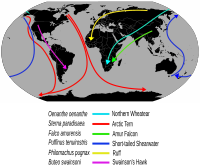
Photo from wikipedia
Background Migrations in temperate systems typically have two migratory phases, spring and autumn, and many migratory ungulates track the pulse of spring vegetation growth during a synchronized spring migration. In… Click to show full abstract
Background Migrations in temperate systems typically have two migratory phases, spring and autumn, and many migratory ungulates track the pulse of spring vegetation growth during a synchronized spring migration. In contrast, autumn migrations are generally less synchronous and the cues driving them remain understudied. Our goal was to identify the cues that migrants use in deciding when to initiate migration and how this is updated while en route . Methods We analyzed autumn migrations of Arctic barren-ground caribou ( Rangifer tarandus ) as a series of persistent and directional movements and assessed the influence of a suite of environmental factors. We fitted a dynamic-parameter movement model at the individual-level and estimated annual population-level parameters for weather covariates on 389 individual-seasons across 9 years. Results Our results revealed strong, consistent effects of decreasing temperature and increasing snow depth on migratory movements, indicating that caribou continuously update their migratory decision based on dynamic environmental conditions. This suggests that individuals pace migration along gradients of these environmental variables. Whereas temperature and snow appeared to be the most consistent cues for migration, we also found interannual variability in the effect of wind, NDVI, and barometric pressure. The dispersed distribution of individuals in autumn resulted in diverse environmental conditions experienced by individual caribou and thus pronounced variability in migratory patterns. Conclusions By analyzing autumn migration as a continuous process across the entire migration period, we found that caribou migration was largely related to temperature and snow conditions experienced throughout the journey. This mechanism of pacing autumn migration based on indicators of the approaching winter is analogous to the more widely researched mechanism of spring migration, when many migrants pace migration with a resource wave. Such a similarity in mechanisms highlights the different environmental stimuli to which migrants have adapted their movements throughout their annual cycle. These insights have implications for how long-distance migratory patterns may change as the Arctic climate continues to warm.
Journal Title: Movement Ecology
Year Published: 2021
Link to full text (if available)
Share on Social Media: Sign Up to like & get
recommendations!